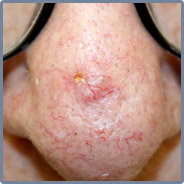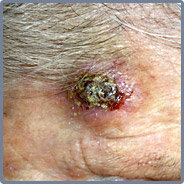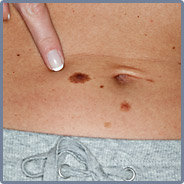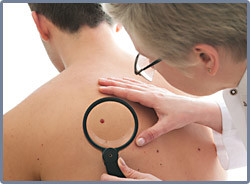Skin Cancer Treatment
Here is an overview of the three most serious skin cancers that require skin cancer treatment, which is provided at our office in Nashua, New Hampshire.
The most common cause of skin cancer is over-exposure to ultra-violet (UV) rays, especially from the sun. The most common warning sign of skin cancer is a change to your skin. And the most common change is something growing on your skin. This growth can appear on the skin in many ways. The following explains the signs (what you see) and symptoms (what you feel) of the most common types of skin cancer:
-
Basal Cell Carcinoma
This is the most common type of skin cancer. It most often appears on skin that gets lots of sun, such as the face, scalp, neck, hands and arms. You will find basal cell carcinomas on other parts of the body, too. It can appear on parts of the body that did not get lots of sun, such as the genitals.
Basal cell carcinoma often grows slowly. It may look like a:
— Reddish patch of dry skin that won’t heal;
— Flesh colored (or pink, red, or brown) pearl shaped lump;
— Pimple that just won’t clear;
— Sore that bleeds, heals, and the returns;
— Scar that feels waxy – may be skin colored, white or yellow;
— Group of slow growing, shiny pink or red growths – looks like sore, often scaly and bleed easily;
— Flat or sunken growth – feels hard, may be white or yellow.For more detailed information on basal cell carcinoma, click here.
Squamous Cell Carcinoma
This is a very common type of skin cancer. It often appears on skin that got lots of sun, on an ear, face, bald scalp, neck or arm. But it can appear elsewhere – even inside the mouth, on the lip, or on the genitals.
Too much sun is often the cause, but it is not the only cause. Squamous cell carcinoma can appear on skin that was badly burned, had lots of radiation (such as x-rays), or was exposed to strong chemicals.
Squamous cell carcinoma often has a reddish color. Without treatment, it can grow deeply. If this happens, the cancer can spread to other parts of the body. This can be deadly. Squamous cell carcinoma often looks like a:
— Hard (scaly or crusty) reddish bump, patch, or pearl shaped growth;
— Open sore that itches and bleeds; it can heal and return;
— Scaly patch on the lip; skin on the lip can get thick.For more detailed information on squamous cell carcinoma, click here.
Melanoma
Know where you have moles on your skin! Melanoma often appears in an existing mole or looks like a new mole. By knowing where you have moles on your skin, you can find melanoma when it first appears.
For more detailed information on melanoma, click here.
-
Who Gets Skin Cancer?
Anyone can get skin cancer. Even people who have skin of color get this cancer. Bob Marley, the legendary reggae musician from Jamaica, developed melanoma on his foot. Most people who get skin cancer, however, have lighter skin.
People who are more likely to get skin cancer:
— Spend a lot of time in the sun;
— Use tanning beds or sun lamps;
— Live (or once lived) in an area that gets intense sunlight, such as Florida, the Caribbean, or northern Australia.If this exposure was years ago, a person still has an increased risk. Even if the exposure did not last long, such as lying out for a few summers, there is a greater risk.
Risk Factors for Skin Cancer
Scientists have found that the following increases a person’s risk for getting skin cancer.
Skin: A person’s skin type and the moles on one’s skin affect the person’s risk for getting skin cancer. The risk increases when the person has:
— Fair skin, especially when the person also has blond or red hair and blue, green, or gray eyes
— Had bad sunburns, especially blistering sunburns
— Skin that burns or freckles rather than tans
— 50-plus moles
— Moles called “atypical nevi” or “dysplastic nevi”Family: When a close blood relative has (or had) skin cancer, a person’s risk of getting skin cancer rises. A close blood relative is a parent, brother, sister or child.
Medical history: Having (or having had) any of the following puts a person at greater risk for getting skin cancer:
— Previous skin cancer
— Actinic keratoses. Having actinic keratoses means the skin has lots of damage. This damage increases the risk of getting all types of skin cancer. Sometimes, an actinic keratoses can progress to a type of skin cancer called squamous cell carcinoma.
— Organ transplant. The medicine that prevents the body from rejecting the organ also weakens the immune system. A weak immune system increases the risk of skin cancer.
— Bad burn. Skin cancer can develop where the skin has been badly burned.
— X-ray treatments. Receiving many x-ray treatments to treat a medical condition increases the risk. This takes many years to develop.
— Disease that weakens the immune system. Lymphoma and human immunodeficiency virus (HIV) are a few diseases that weaken the immune system.
— Xeroderma pigmentosum. People who inherit this rare disease get many skin cancers.
— Gorlin’s syndrome (also called basal cell nevus syndrome). People who have this rare disease can get many basal cell carcinomas early in life. They also have a higher risk for getting melanoma and non-Hodgkin’s lymphoma.
— Exposure to chemicals: People exposed to any of the following have a much higher risk of skin cancer:
— Arsenic (working with or swallowing)
— Coal
— Industrial tar -
How Do Dermatologists Diagnose Skin Cancer?
To diagnose skin cancer, a dermatologist looks at the skin. A dermatologist will carefully examine growth, moles, and dry patches.
To get a better look, a dermatologist may use a device called a dermoscope. The device shines light on the skin. It magnifies the skin. This helps the dermatologist to see pigment and structures in the skin.
If a dermatologist finds something that looks like skin cancer, the dermatologist will remove it (or part of it). The removed skin will be sent to a lab. Your dermatologist may call this a biopsy. Skin cancer cannot be diagnosed without a biopsy.
A biopsy is quick, safe, and easy for a dermatologist to perform. A biopsy should not cause anxiety. The discomfort and risks are minimal.
How Do Dermatologists Treat Skin Cancer?
There are many treatments for skin cancer. A dermatologist selects treatment after considering the following:
— Type of skin cancer
— Where the skin cancer appears on the body
— Whether the skin cancer is aggressive
— Stage of the cancer (how deeply the skin cancer has grown and whether it has spread)
— Patient’s healthAfter considering the above, your dermatologist will choose 1 or more of the following treatments for skin cancer.
Surgical treatment: When treating skin cancer, the goal is to remove all of the cancer. When the cancer has not spread, this is often possible. To remove skin cancer, the following surgical treatment may be used:
— Excision: To perform this, the dermatologist numbs the skin and then surgically cuts out the skin cancer and a small amount of normal-looking skin. This normal-looking skin is called a margin. There are different types of excision. Most excisions can be performed in a dermatologist’s office.
— Mohs surgery: A dermatologist who has completed additional medical training in Mohs surgery performs this procedure. Once a dermatologist completes this training, the dermatologist is called a Mohs surgeon.
Mohs surgery begins with the surgeon removing the visible part of the skin cancer. Because cancer cells are not visible to the naked eye, the surgeon also removes some skin that looks normal but may contain cancer cells.
This part of the surgery is performed one layer at a time. After removing a layer of skin, it is prepared so that the surgeon can examine it under a microscope and look for cancer cells.
If the surgeon sees cancer cells, the surgeon removes another layer of skin. This layer-by-layer approach continues until the surgeon no longer finds cancer cells. In most cases, Mohs surgery can be completed within a day or less. The cure rate for skin cancer is high when Mohs surgery is used.
— Curettage and Electrodessication: This surgical procedure may be used to treat small basal cell and squamous cell skin cancers. Sometimes, curettage is used alone.
Other Treatments: Surgical treatment is not right for every case of skin cancer. Some patients cannot undergo surgery. Sometimes, surgery cannot remove all of the cancer, and more treatment is used to help get rid of the cancer. If the skin cancer is caught very early, surgery may not be necessary. Other treatments for skin cancer are:
— Immunotherapy: This treatment uses the patient’s own immune system to fight the cancer. The patient applies a cream (generic name is imiquimod) to the skin as directed by the dermatologist.
— Cryosurgery: The dermatologist freezes the skin cancer. Freezing destroys the treated area, causing the skin and cancer cells to slough off.
— Chemotherapy Applied To the Skin: The generic name for the medicine used in the treatment is 5-fluorouracil or 5-FU. The patient applies 5-FU to the skin cancer. It destroys the damaged ski cells. When the skin heals, new skin appears.
— Chemotherapy: If the cancer spreads beyond the skin, chemotherapy may kill the cancer cells. When a patient gets chemotherapy, the patient takes medicine. This medicine may be swallowed, injected (shots) or infused (given with an IV). The medicine travels throughout the body and kills the cancer cells. The medicine also destroys some normal cells. This can cause side effects, such as vomiting and hair loss. When chemotherapy stops, the side effects usually disappear.
— Phototherapy: This treatment consists of two phases. First, a chemical is applied to the skin cancer. This chemical sits on the skin cancer for several hours. During the second phase, the skin cancer is exposed to a special light. This light destroys the cancer cells.
— Radiation Therapy: Radiation may be used to treat older adults who have a large skin cancer, skin cancers that cover a large area, or a skin cancer that is difficult to surgically remove. Radiation therapy gradually destroys the cancer cells through repeat exposure to radiation. A patient may receive 15 to 30 treatments. This treatment is often only recommended for older adults. Many years after a person is exposed to radiation, new skin cancer can develop.What Outcome Can Someone With Skin Cancer Expect?
If it is caught early and properly treated, skin cancer can be cured. Even melanoma, which can be deadly, has a cure rate of almost 100% when treated early.
Even if you get a clean bill of health, you need to continue to see your dermatologist. Once a person gets skin cancer, the risk of getting another skin cancer is higher. Sometimes skin cancer returns. Your dermatologist will tell you how often you should return for checkups.
Without early treatment, the outcome is not as favorable. Skin cancer can grow deeply. Removing the cancer can mean removing muscle and even bone. Reconstructive surgery may be needed after the surgery to remove the skin cancer. And skin cancer can spread.
If the cancer spreads, treatment can be difficult. Treatment may not cure cancer that spreads.







